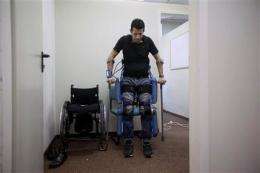Israeli device lets paralyzed people stand, walk

When Israeli entrepreneur Amit Goffer was paralyzed in a car crash in 1997, he went on a quest to help other victims walk again.
He started wondering why the wheelchair is the only way for the paralyzed to get around, short of being carried.
So he invented an alternative: robotic "pants" that use sensors and motors to allow paralyzed patients to stand, walk and even climb stairs. He founded a company, Argo Medical Technologies Ltd., to commercialize it.
After several years of clinical trials in Israel and the United States, units will go on sale in January to rehabilitation centers around the world.
Argo joins several companies that have developed robotics and exoskeletons in medicine.
Called "ReWalk," the latest device can help paraplegics to stand and walk - using crutches for stability - when they lean forward and move their upper body in different ways.
The 35-pound (16-kilogram) device, worn outside of clothing, consists of leg braces outfitted with motion sensors and motorized joints that respond to subtle changes in upper-body movement and shifts in balance. A harness around the patient's waist and shoulders keeps the suit in place, and a backpack holds the computer and rechargeable 3 1/2-hour battery.
When operated, it makes clanging robotic sounds, like the hero of the 1980s cult movie "Robocop."
"ReWalk is a man-machine device. The machine cannot walk by itself. The user cannot walk by himself. Only when they are together they can walk," said Oren Tamari, Argo's chief operating officer.
He said regular usage of the device, which costs about $100,000, would prevent costly complications that often arise in people who can't walk, including pressure sores and urinary, digestive, circulatory, and cardiovascular problems.
The ReWalk arrives at a boom time for such devices in medicine.
Tibion Corp. of Sunnyvale, Calif., is promoting a "Bionic Leg" quite similar to ReWalk, but intended to help stroke patients walk again. Ossur of Iceland makes a powered knee prosthesis that lets amputees walk.
ReWalk will have competition in targeting paraplegics. Last month, Berkeley Bionics of Berkeley, Calif., unveiled eLEGS. The exoskeleton will begin clinical trials early next year in rehabilitation clinics. A limited release of eLEGS is scheduled during the second half of 2011.
New Zealand-based Rex Bionics has developed a fully robotic, joystick operated unit, and others have marketed performance augmentation units that are not necessarily designed for the handicapped.
Goffer is paralyzed from the neck down, and ReWalk users need their hands and shoulders to operate it and support crutches, so he is not yet able to enjoy his creation. But he said the company is working on a version for quadriplegics such as himself.
Those who have tested it say the benefit is more than physical.
"When I use the ReWalk I feel like I am maintaining my body. It is like taking a car to the garage ... It feels great," said Radi Kaiuf, a ReWalk evaluator who was paralyzed in 1988 during his Israeli military service.
"I have a 3-year-old daughter. The first time she saw me walking, she was silent for the first few minutes and then she said, `Daddy you are tall.'" It made me feel so good, like I was soaring."
More information:
Argo Medical Technologies Ltd.: http://www.argomedtec.com
Berkeley Bionics: http://www.berkeleybionics.com
©2010 The Associated Press. All rights reserved. This material may not be published, broadcast, rewritten or redistributed.


















